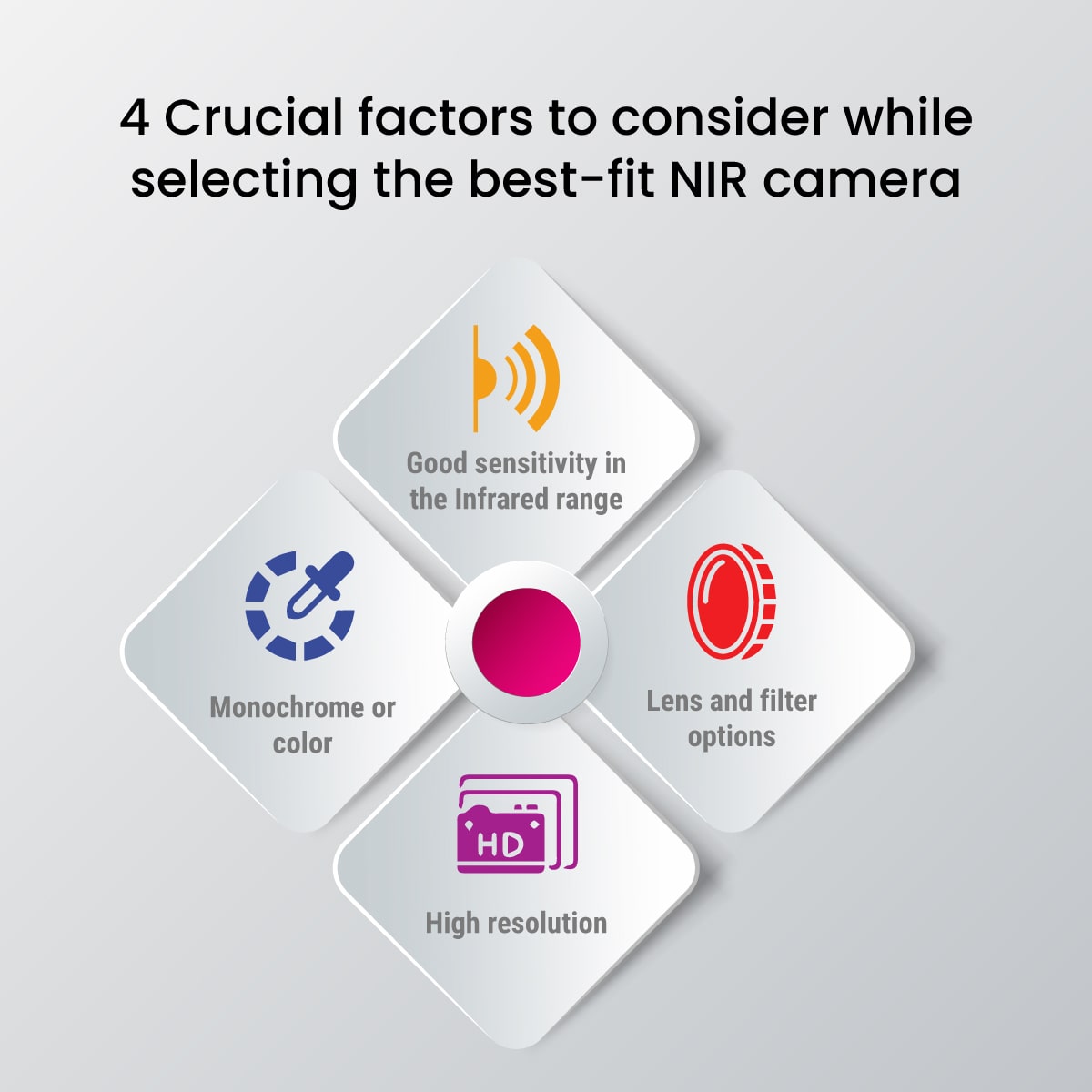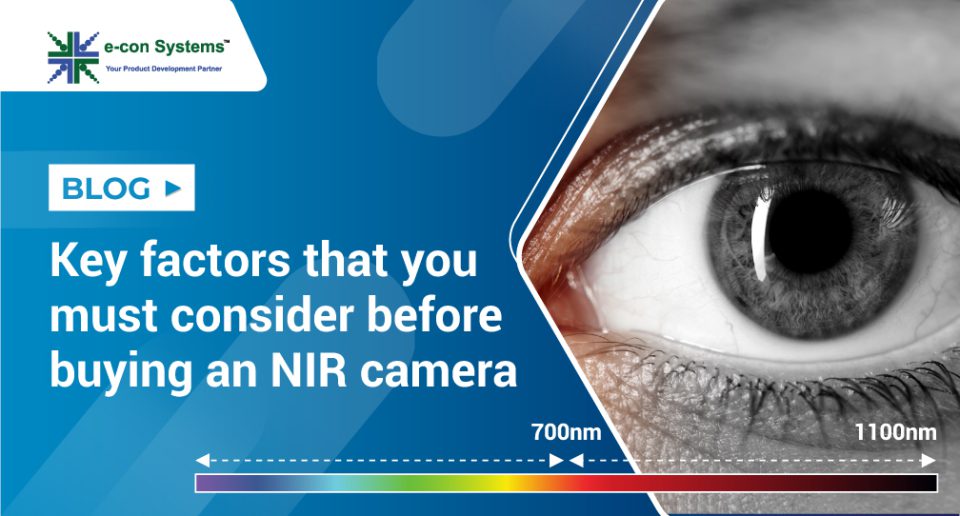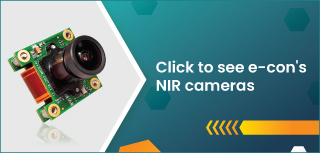Near-Infrared (NIR) imaging is growing in demand around the globe, with a focus on product quality improvement and production rationalization. Some of its popular use cases include night vision surveillance, industrial image processing, spectroscopy, food inspection, etc. This has led to the explosion of several NIR cameras in the market worldwide.
(To learn more about NIR imaging, please have a look at the article What is NIR imaging? How do NIR cameras work?)
However, finding the right NIR camera to suit your unique needs can seem daunting. After all, different use cases require different top-priority features. Furthermore, there are many options to consider – and with little insights available for informed decision-making.
So, in this blog, you will find all the information required to choose a NIR camera, as well as the four crucial factors to consider while selecting the best-fit one.
Why do you need to choose a NIR camera?
The biggest advantage that NIR cameras offer is their ability to illuminate images without the need for increasing visible light. When it comes to imaging in dark environments, NIR cameras provide brighter images without having to bring in external light sources.
How this works is that when different objects are exposed to a NIR camera, it uniquely reflects light based on the composition. Hence, it can provide more details of a scene that may be difficult otherwise to determine simply by using visible light.The spectral sensitivity of the human eye lies between 380 nm – 700 nm. While the visible range can be covered by ordinary cameras that are sensitive to the visible spectrum, the NIR range of 850 nm – 1400 nm can only be covered using NIR cameras.
Key factors that should be considered before buying a NIR camera
- Good sensitivity in the Infrared range
- Lens and filter options
- High resolution
- Monochrome or color

Good sensitivity in the infrared range
NIR sensitivity is essential for these cameras to capture the infrared response of a scene. Responsivity is synonymous with sensitivity and also indicates the efficiency of an imager in converting photons from a low light scene into detailed images. Cameras with high Near-Infrared (NIR) responsivity come with high quantum efficiency in the spectrum which is useful for night vision applications.
Lens and filter options
The Field of View (FOV) is determined by the camera lens and refers to the extent of the scene that the NIR camera can capture. The greater the field of view, the greater the area or space that can be captured with the camera. A camera that allows you to change the lens increases its versatility.
NIR cameras with interchangeable M12 lens mounts allow any kind of lens for meeting specific application requirements. There is also a variety of M12 lenses available off-the-shelf – along with many filters that can be used. Examples of filters include visible-block & IR-pass, IR Band-pass, IR narrowband filters, etc.
Interested in finding the FOV required for your application? Jump right into our FOV calculator
High resolution
The resolution of a NIR camera heavily impacts the quality of the rendered image. The resolution indicates the number of pixels, and thus more pixels means higher resolution. The higher the resolution, the sharper and more accurate each point in the image will be, allowing the capture of superior quality images.
Monochrome or color
The key difference between a monochrome and a color camera is the absence of a Color Filter Array (CFA) in the former. The removal of this optical band pass filter allows for a greater number of photons to reach the photosensitive surface of the sensor in a monochrome camera. This results in rendering it more sensitive to light which increases quantum efficiency.
Also, color cameras usually have IR cut filters to prevent infrared light from generating color aberrations. Without these filters, the red, green, and blue pixels would also react to various wavelengths in the NIR band resulting in the generation of strange and inaccurate colors.
Since each pixel of a monochrome sensor can detect a broader spectrum of light due to the absence of the CFA and IR cut filter, the overall performance of the camera improves significantly in low light conditions. Additional improvements are therefore observed at higher wavelengths, specifically beyond 650 nm, where Near Infrared (NIR) begins.
In conclusion
We hope you found some useful insights to help narrow down which type of NIR camera solution is best suited for your application. At e-con Systems™, we have close to 20 years of experience in helping businesses build cutting-edge camera systems. We have designed, developed, and deployed world-class NIR cameras with a high-sensitivity level for maximum performance. They come with about 30% quantum efficiency in the 850nm range.
Our list of NIR camera modules:
- See3CAM_CU27 – Sony STARVIS IMX462 ultra low light USB camera
- See3CAM_CU135M – 4K monochrome USB 3.1 Gen 1 camera
- See3CAM_CU55M – 5MP monochrome USB NIR camera
- See3CAM_20CUG – 2MP OV2311 monochrome global shutter camera
- See3CAM_CU30 – 3.4 MP low light USB camera
You could also visit our Camera Selector to have a look at e-con’s entire portfolio of cameras which includes not just NIR cameras, but cameras with a wide variety of features such as HDR, global shutter, low light performance, low noise, stereo, etc.
If you are looking for help in integrating cameras into your products, please write to us at camerasolutions@e-consystems.com.

Prabu is the Chief Technology Officer and Head of Camera Products at e-con Systems, and comes with a rich experience of more than 15 years in the embedded vision space. He brings to the table a deep knowledge in USB cameras, embedded vision cameras, vision algorithms and FPGAs. He has built 50+ camera solutions spanning various domains such as medical, industrial, agriculture, retail, biometrics, and more. He also comes with expertise in device driver development and BSP development. Currently, Prabu’s focus is to build smart camera solutions that power new age AI based applications.




4 comments
I was going through your Near IR Camera – Using these IR cameras would I be able to spot water leaks, mold, pests and electrical hazards?
See3CAM_12CUNIR – Can this camera be connected to gumstix boards?
Hi John – Thank you for your interest towards our Near IR Cameras – Yeah, you may opt See3CAM_12CUNIR which is Optimized for good sensitivity in NIR range with about 30% quantum efficiency in 850nm range.
@nash – Yes, See3CAM_12CUNIR can be connected to Gumstix board via USB 2.0 Interface.